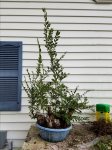Dorky_gearhead
Shohin
This might belong in the general forum, but... my neighbor has several elm Trees that the landlord wants removed.
How would a novice ID an elm tree without previous species knowledge? As of right now I would be googling "how to id elm trees" and proceed to sift through many many pictures in a feeble attempt to get an exact ID. I understand that its going to be a combination of the bark and the leaves, but beyond that I'm at a loss.
I guess at some point I should make a flow chart for ease. That should help me remember lol
How would a novice ID an elm tree without previous species knowledge? As of right now I would be googling "how to id elm trees" and proceed to sift through many many pictures in a feeble attempt to get an exact ID. I understand that its going to be a combination of the bark and the leaves, but beyond that I'm at a loss.
I guess at some point I should make a flow chart for ease. That should help me remember lol





